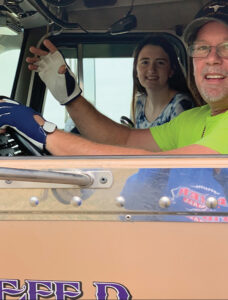Finding Real Solutions to Real Problems

Finding real solutions to real problems in the agricultural industry—that’s the purpose of agriscience projects in agricultural education and FFA.
“Agriscience projects give students real-world, hands-on experiences in agricultural enterprises,” says Lora Rapp, Rich Hill agricultural education teacher and FFA advisor. “Students use scientific principles and new technologies to solve problems related to agriculture and food.”
Rich Hill FFA member Katelynn Tourtillott set out to find a solution to one of those real-world problems last fall.
She started by noticing there was an issue.
“I come from a family of semi-truck drivers,” Tourtillott says. “My dad, grandfather, uncle and several of my cousins are truck drivers. Most of them suffer from lower back pain. I began to do research on this topic and noticed that many older farmers also suffer from back pain.”
Further research turned up a proposed answer. “It has been concluded that the vibrations from the machinery cause pain,” she explains.
Tourtillott decided to conduct an agriscience experiment to search for a solution that would help farmers and truck drivers like those in her family.
“I began to communicate with farmers around my area and decided to conduct an experiment on using shock-absorbing gloves,” she says. “I wanted to see if the gloves could lessen the lower back pain in farmers. I asked several different production agriculture farmers to wear the gloves while they were working. They wore them every day for two weeks, then went for two weeks without them. They logged their pain each morning and night on a pain chart.”
Her agriscience project took planning and preparation. Tourtillott says that after researching several different types of gloves, she moved forward with a pair that wouldn’t limit mobility so the farmers could wear them consistently.
Tourtillott was pleased when she analyzed her results.
“My favorite part of the project was hearing that the farmers actually got relief from the gloves,” she says. “One of the participants had back surgery a few years ago to try and help manage his pain. When he told me the gloves helped decrease the constant pain, it showed that my hard work paid off.”
In addition to finding a proposed solution to help with farmers’ back pain, Tourtillott experienced personal growth along the way.
“I improved my time management and planning skills during this project,” she explains. I prioritized what needed to be done first to ensure my project was accurate and simple for the farmers to participate in.”
Rapp explains that she promotes agriscience as well as the process behind the projects to her students because of the personal growth that can occur.
“It teaches students scientific methods and makes them think on a deeper level,” she says. I challenge my students to think outside the box or think of something that could benefit agriculture or their SAE.”
An added benefit of these projects is the effect they can have on local agriculture.
“Not all people will have the same results as the individuals used in Katelynn’s research,” Rapp says. “The farmers chosen have been experiencing back pain for a long time. Each individual has different tolerance levels for pain. But these results can give farmers an additional tool to use to help manage back pain.”
Tourtillott is hoping her results impact farmers in a way that benefits their individual operations as well as the industry as a whole.
“If they can use the gloves to help minimize and control their pain, they can maximize their productivity and efficiency in the fields,” she says. “I believe my results can help farmers find and use a tool to help them with their back pain. Farmers are essential to the world’s economy and food supply, so I want to help farmers do their job to their fullest potential.”
—By Brandelynn Martin Twellman




